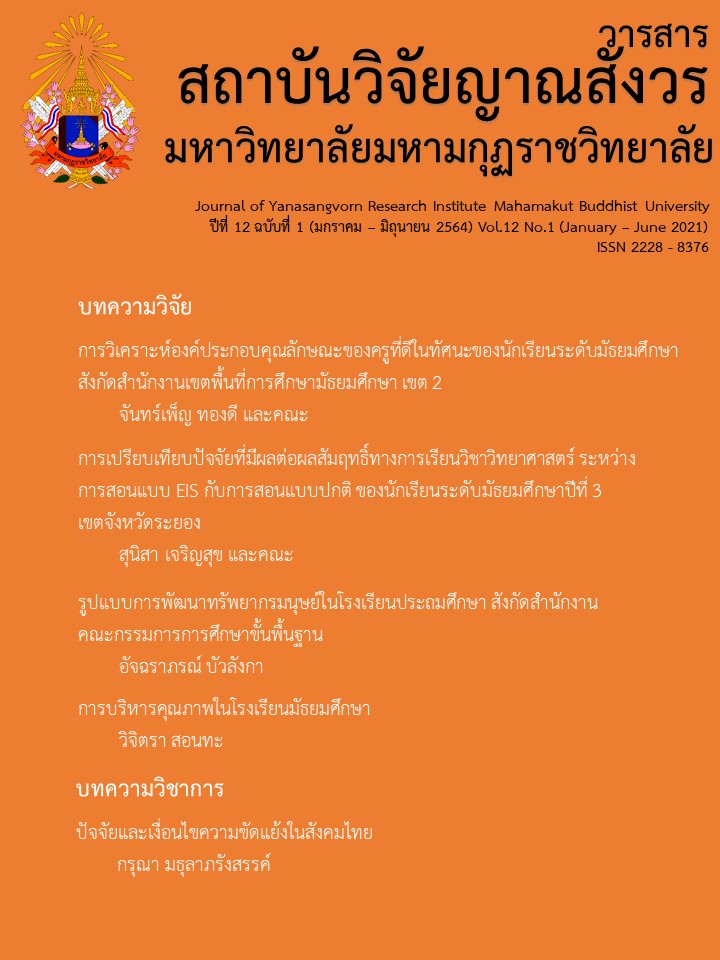THE QUALITY MANAGEMENT IN SECONDARY SCHOOL
Main Article Content
Abstract
This research article had the objectives as follows: 1) identify the components of quality management in secondary school 2) verify the components of quality management in secondary school. The samples were 100 world class standard school. The respondents 300 persons. The research instruments were semi-structured interview, opinionnaire and questionaire (for confirm the components). The statistical used for data analyzing were frequency, percentage, arithmetic mean, standard deviation, exploratory factor analysis and content analysis. The research findings were as follow: The components of quality management in secondary school consist of 4 main components and 9 sub-components were 1) Academic Management 1.1) Participatory academic management 1.2) Enhancing learning environment 1.3) Enhancment of learner’s competencies 2) Strategic management 2.1) Strategic planning 2.2) Strategy implementation driving 2.3) Monitoring and Evaluation of Achievement 3) Human resource development 3.1) Continuous personal development 3.2) Build up of satisfaction and engagement in school 3.3) Build up of school core value and 4) Monitoring Evaluation and improvement. The factor loading of observed one variable values between 0.501 to 0.812. Variance of variable can explain 52.95 percent and the experts confirmed that the components they were accuracy, propriety, feasibility and utility.
Article Details
References
ดิเรก วรรณเศียร ประสิทธิ์ เขียวศรี และนพรุจ ศักดิ์ศิริ. (2553). การวิจัยและพัฒนารูปแบบการจัดการศึกษาโรงเรียนมาตรฐานสากล สำนักงานคณะกรรมการการศึกษาขั้นพื้นฐาน. กรุงเทพฯ: โรงพิมพ์ชุมนุมสหกรณ์การเกษตรแห่งประเทศไทย.
บวรศิลป์ เชาวน์ชื่น. (2557). การประยุกต์ใช้เกณฑ์ด้านการศึกษาของมัลคอมบัลดริจ (Malcolm Baldrige Education Criteria) เพื่อบูรณาการการจัดการศึกษาระดับอุดมศึกษา. วารสารประกันคุณภาพ.
บุญยกุล หัตถกี. (2556). รูปแบบการบริหารคุณภาพการศึกษาสู่ความเป็นเลิศของโรงเรียนขนาดเล็ก. ปริญญาดุษฎีบัณฑิต มหาวิทยาลัยบูรพา ชลบุรี.
รังสรรค์ นกสกุล บุญเรือง ศรีเหรัญ และจูไร โชคประสิทธิ์. (2553). การพัฒนารูปแบบความสัมพันธ์เชิงสาเหตุขององค์ประกอบที่ส่งผลต่อการบริหารงานโรงเรียนมาตรฐานสากล. วารสารบัณฑิตศึกษา มหาวิทยาลัยราชภัฎวไลยลงกรณ์ ในพระบรมราชูปภัมภ์, 6(1), 61-76.
สุริยา ห้าวหาญ ธัชชัย จิตรนันท์ และวีรพล สารบรรณ. (2559). รูปแบบการบริหารสู่ความเป็นเลิศของสถานศึกษาสังกัดสำนักงานเขตพื้นที่การศึกษามัธยมศึกษา. วารสารศึกษาศาสตร์มหาวิทยาลัยมหาสารคาม, 10(3), 202-220.
สมาพร ลี้ภัยรัตน์ ธานี เกสทอง และนันทิยา น้อยจันทร์. (2560). รูปแบบการบริหารคุณภาพโรงเรียนมาตรฐานสากลระดับประถมศึกษา. วารสารสุทธิปริทัศน์, 31(100), 261-273.
สำนักงานคณะกรรมการการศึกษาขั้นพื้นฐาน. (2553). โรงเรียนมาตรฐานสากลคู่มือการบริหารจัดการระบบคุณภาพ. กรุงเทพฯ: ชุมนุมสหกรณ์การเกษตรแห่งประเทศไทย.
สำนักงานคณะกรรมการการศึกษาขั้นพื้นฐาน. (2555). แนวทางการจัดการเรียนการสอนในโรงเรียนมาตรฐานสากลฉบับปรับปรุง. กรุงเทพฯ: โรงพิมพ์ชุมนุมสหกรณ์การเกษตรแห่งประเทศ.
สำนักงานเลขาธิการ กระทรวงศึกษาธิการ. (2552). ข้อเสนอการปฏิรูปการศึกษาในทศวรรษที่สอง (พ.ศ. 2552-2561). กรุงเทพฯ: พริกหวานกราฟฟิค.
สำนักบริหารงานการมัธยมศึกษาตอนปลาย. (2557). เกณฑ์รางวัลคุณภาพแห่งสำนักงาน คณะกรรมการการศึกษาขั้นพื้นฐาน (OBECQA) ของโครงการโรงเรียนมาตรฐานสากลปี2557-2558. กรุงเทพฯ: โรงพิมพ์ชุมนุมสหกรณ์การเกษตรแห่งประเทศไทยจำกัด.


